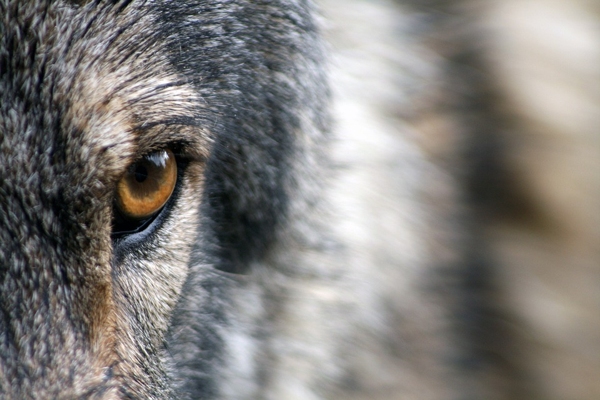One of the two remaining East Fork wolves of Denali National Park was
shot this past weekend by a trophy hunter at a bear baiting station just
outside park boundaries.
If this sounds eerily familiar, that's because it is. This is just what
happened exactly one year ago, when the pregnant female of the East
Fork group was shot by an Outside trophy hunter at a bear baiting
station in the same area. The loss of that one pregnant female wolf in
2015 led to the disintegration of the entire East Fork group, also
called the Toklats, from 15 wolves down to just two this spring.
And now, with last weekend's shooting of the radio-collared gray male
dubbed "1508 GM" by park biologists, it appears the East Fork is down to
one lone black wolf.
This is a historic loss. It leaves one remaining member of the wolf
group studied by Dr. Adolph Murie, the subjects of his groundbreaking
1944 book, "The Wolves of Mount McKinley." It leaves one from the group
that Dr. Gordon Haber continued to study for another 43 years, until his
untimely 2009 death in a plane crash while studying wolves.
This one family group of wolves was studied for a continuous 70 years,
making them, along with the community of chimpanzees studied by Jane
Goodall, the world's oldest-known, longest-studied large mammal social
lineage in the wild. It doesn't take a rocket scientist to see that this
gave the East Fork wolves inestimable scientific value.
But the state of Alaska apparently has no interest in such rare
scientific value, no pride in a scientific record rivaled only by that
of Goodall's chimpanzee research. The state has allowed this valuable
public wildlife resource to be decimated by hunting and trapping for
decades. And the National Park Service has clearly failed its mandate of
protecting natural processes in the park.
The state also seems to lack regard for the hundreds of thousands of
visitors each year who come to Denali to see wolves, many of them
Alaskans. With the loss of the East Fork group in 2015, and the Grant
Creek group in 2012 (also from hunting/trapping along the park
boundary), viewing success of Park wolves plummeted. Almost half of park
visitors were seeing wolves in the park until these deaths; now only
about 5 percent are so fortunate.
The East Fork wolves traditionally denned near the Murie cabin at
Toklat River, and were the wolves most visitors saw throughout the 1980s
and 1990s — until a series of deaths at the hands of humans beginning
in 2001 compromised the family group. With just a half-dozen
inexperienced yearlings left, they shifted their territory and became
even more susceptible to trapping and hunting on the northeastern
boundaries of the park. They remained one of the most-viewed family
groups until last spring.
The fault for the demise of these world-famous wolves rests squarely on
the shoulders of Alaska Department of Fish and Game Commissioner Sam
Cotten. He may not have pulled the trigger, but he permitted it.
In February 2015, we requested that he issue an emergency closure to
prevent this precise situation. Cotten refused, and in May that year the
pregnant alpha female of East Fork was shot by a hunter at a bear
baiting station just outside the park boundaries. After her death,
Cotten did — finally, but too late — issue a two-week emergency closure.
Too late, because with her death, there were no pups, no denning and
the 15-member family group fragmented down to two wolves.
In March 2016, even the Alaska Board of Game agreed that the wolf
hunting season in the area along the Denali boundary should be closed by
April 15, rather than May 31, but their newly adopted regulation
doesn't take effect until 2017. Thus, on the same day of the Board
decision, we again requested an emergency closure in the area to protect
the remaining two East Fork wolves (and other park wolves using the
area), hoping to prevent this tragic situation from happening again.
Again, Cotten ignored the request. And again, last weekend another
trophy hunter at a bear baiting station shot and killed 1508 GM —
possibly the last male East Fork wolf.
This leaves one lone survivor, who may be a pregnant female, as the
National Park Service recently observed these two wolves involved in
denning activities. Either way, it would take a miracle for her, and her
pups, to survive. Without another adult to hunt and feed the nursing
mother, the pups will likely starve to death.
These events likely spell the extinction of the world-renowned East
Fork family group. All because Commissioner Cotten failed not once, but
twice, to do the prudent and intelligent thing, and close the area.
Enough is enough. It's way past time for the state to wake up.
Commissioner Cotten needs to acknowledge the facts of this situation,
issue a public apology for the loss of this world-famous wolf group, and
close the area immediately. And both he and Gov. Bill Walker need to
stop dragging their feet and start attending to this issue with the
sense of urgency and public interest that it most surely deserves.
Partial solutions will not work, and the Board of Game will not be part
of a real and permanent solution. What we Alaskans, the hundreds of
thousands of tourists and the park wolves desperately need is a
permanent wildlife conservation easement along this northeastern
boundary of the park.
With an easement, next spring we won't see this tragedy recur. It's
highly unlikely there will be any East Fork wolves left to fall prey to a
bear-baiting sport hunter, but perhaps their legacy is to remind us why
we must make this work, and now.
Marybeth Holleman
is author of several books including "Among Wolves: Gordon Haber's
Insights into Alaska's Most Misunderstood Animal." In 2012, she was
artist-in-residence in Denali National Park. www.marybethholleman.com.
source



No comments:
Post a Comment